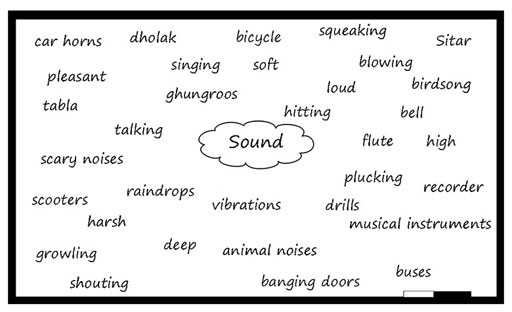4 Using the brainstorms for learning
There are many ways to use the outcomes from brainstorming. They can be your way of seeing the students’ initial ideas about sound or another area of science so that you can plan how to extend their understanding into the more scientific concepts that appear in the science textbooks.
The results of a brainstorm can be used to monitor students’ progress – they can do this either themselves or in conjunction with you. Brainstorming is fun, quick and fast to do, and so a good way of gathering pertinent information from a range of students with different abilities in your class.
Now read Case Study 3, which describes how one teacher worked with the results of her class’s brainstorm to plan a lesson that would extend their thinking about how sound is produced. Resource 2, ‘Assessing progress and performance’, provides insight into how make use of information gathered about students’ understanding and progress.
Case Study 3: Using information from a class brainstorm
Ms Dha had done a brainstorm on ‘sound’ with her class, which is shown below. She explored their understanding further with a few questions before she used the brainstorm to plan her next lesson.
I asked for all the words and ideas that had come into my students’ minds when I said the word ‘sound’. I listed them randomly on the blackboard. After a few minutes I stopped and thanked the class for their ideas. I asked a few questions about some of their answers so that I could explore what they knew about what they had said. I realised that most of them could describe types of sounds easily but were not as able to describe how sounds were made and what caused the variations in sound. I decided to use the outcomes of this brainstorm to plan how to help them understand how sounds are made and can be modulated.
First I looked closely at the brainstorm again and grouped the words into different areas [Figure 4].

I listed the instruments that students mentioned first, then the descriptions of sounds and types of sound they had suggested. Finally I looked for words that could be related to how sounds are made. In this list I put ‘blowing’, ‘banging’, ‘vibrations’, ‘talking’ and ‘plucking’. Then I did the same with types of sounds. I had asked them to explain more about these ways of making sound, but they had not been able to explain what really happened.
To start my planning I had the idea of using four musical instruments that you had to hit, pluck or blow to make a sound, as well as gathering a few ordinary objects that could be used to make sound, like an empty tin, a gourd, some string and rubber bands. I realised that the students could make sound but did not know what caused the sound, so I also took in some rice that I could put on the drum to show the vibrations.
I planned a series of short activities where students working in pairs could try out different ways of making sound. As they did this I could ask them to think about what causes the sound. I will encourage them to put their hands on the objects and instruments so that they can feel the vibrations. I will then draw them a diagram about how sound is made when I think all of them have the idea of vibrations.
I will arrange all the little activities around the room and they can move in turn from one to another. They will not have to do all of them but at least four or five.
Activity 4: Using the outcomes of your student’s brainstorm to plan next steps
Try doing a similar kind of activity to Mrs Dha in Case Study 3, where she explored how sounds are made.
- How you could adapt such a plan for your class?
- What areas of sound do your students need help in understanding?
- Having identified these, think what activity (or activities) you could do to help the students explore how sounds are made.
- If you have a large class, it may be that you work with one group at a time to try some simple activities about vibrations, while the rest of the class are working on some text-based activity.
- Try the activities.
- Write a few notes on how the students responded and what you think they learnt from the experience. How do you know this?
You saw how Ms Dha found out what her class knew and where gaps occurred in their knowledge. She analysed their responses and categorised them to into key aspects of sound, choosing to first focus on how sound is caused. Her next step might be to explore the range of sound that can be produced by modifying the way that instruments and objects are played. Giving students concrete experiences of producing sounds will help them understand vibrations much better.
Brainstorming has helped Ms Dha to direct her teaching more directly to her students’ needs. Such an approach could have the same positive impact for you.
3 Using the information generated by a brainstorm effectively
